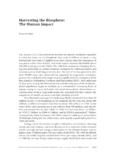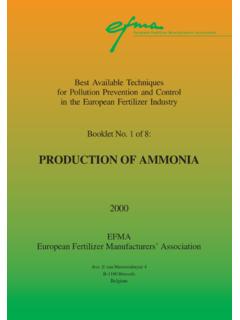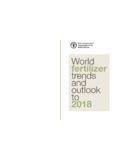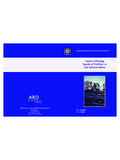Transcription of scientific Nitrogen cycle and world food production
1 world AGRICULTURE9scientificRelative neglect and existential necessityConcerns about rapid globalwarming anthropogenicemissions of carbon dioxide(CO2) and the resulting planet-widerise of tropospheric temperatures andalteration of carbon cycle have cometo dominate not only media attentionbut also scientific debates in generaland environmental concerns inparticular. A simple search of GoogleNews reveals the information gap. InJanuary 2011 the site listed more than700 items for the carbon cycle butfewer than 90 items for the nitrogencycle. I would argue that the realpublic awareness gap is much greaterthan this, an order of magnitudedifference, as the comparison includesmany references to papers publishedin scientific journals whose content willnever become widespread attention disparity is curiousbecause human interference in thenitrogen cycle is incomparably moremassive than our perturbance of thecarbon cycle .
2 This is because most ofthe disruption is due to that mostfundamental of all energy conversions,the production of food . In absoluteterms anthropogenic emissions ofcarbon from fossil fuel combustion(nearly 9 Gt C/year) are less than 10%of the annual carbon uptake byterrestrial photosynthesis. In contrast,human activities (fertilisers, planting oflegumes and emissions of nitrogenoxides from combustion) now releaseabout as much reactive Nitrogen (about 150 Mt N) as is formed bynatural processes (biofixation,lightning). There is no possibility thatwe will be able to produce foodwithout Nitrogen . Therefore, thenitrogen cycle and human interferencein its functioning should get at least asmuch attention as our current (and Iwould argue exaggerated)preoccupation with global climatechange.
3 Understanding the cycleStudies of the Nitrogen cycle go backto the period of pioneering researchthat laid the foundation of modern lifesciences during the 19th century (Smil2001). Justus von Liebig, one of thefounders of organic chemistry,formulated the law of the minimum(plant growth is limited by theNitrogen cycle and world food productionVaclav SmilDistinguished Professor in the Faculty of Environment, University of Manitoba, Winnipeg, CANADA. SummaryPIn the biosphere Nitrogen has the most complex cycle of all circulating elements. Its incessant reuse makes life onEarth possible. Traditional agricultures supplied limited amounts of the nutrient by recycling organic wastes and byplanting leguminous crops. Only the Haber-Bosch synthesis of ammonia, first commercialised in 1913, removed thiskey constraint on crop productivity.)
4 Global agriculture has become steadily more dependent on synthetic nitrogenouscompounds without whose applications we would not be able to produce roughly half of today s world high, and rising, dependence exacts a considerable environmental price, as the losses of Nitrogen fertilisers lead tocontamination of waters, eutrophication, and excessive atmospheric deposition and emissions of a potent greenhousegas. Inefficient use of nitrogenous fertilisers is also an obvious economic loss and a waste of natural gas, the primefeedstock and energiser of ammonia synthesis. There is no single measure that could substantially cut these losses butthey can be reduced by careful agronomic management and (most effectively, but controversially) by moderateconsumption of animal foodstuffs.
5 In any case, more Nitrogen will be needed to feed the additional billionpeople that will be added to the global population before its growth levels off later in this : degradation of water quality owing to enrichment by nutrients, primarily Nitrogen (N)and phosphorus (P) which results inexcessive plant (principally algae)growth and : produced by : lowest layer of theearth s atmosphere, below on Earth would beimpossible without incessantcycling of key elements thatmake up biomass. Three cycles those of carbon, Nitrogen andsulphur are particularlynoteworthy: carbon is, ofcourse, the dominantconstituent of all living matter(typically 45-50% of dryweight). Proteins cannot bemade without Nitrogen , anddisulphide bridges make theproteins three-dimensional,ready to enter into myriads ofenzymatic reactions.
6 Proteinsalso act as signalling andstructural compounds. The threecycles are remarkable because oftheir complexity, theimportance of microbes in theirfunctioning and because thecycled elements are transportedby both air and water and henceable to move far away fromtheir Gt, gigatonne, or 109tonnes, 1012kg. Mt, megatonne, or 6/4/11 12:20 Page 110 world AGRICULTURE scientific With average crop yields remaining at the 1900 level the crop harvest in the year 2000 would have required nearly four times more land and the cultivated area would have claimed nearly half of all ice-free continents element that is present in the soil inthe least adequate amount), publishedthe first concepts of global biosphericcycles and recognised the importanceof Nitrogen in crop production bycontrasting it with forestry: Agriculturediffers essentially from the cultivationof forests, inasmuch as its principalobject consists in the production ofnitrogen under any form capable ofassimilation; whilst the object of forestculture is confined to the productionof carbon (Liebig 1840).
7 Jean-Baptiste Boussingault (1802-1887) found that the nutritional valueof fertilisers is proportional to theirnitrogen content and demonstratedthat legumes can restore Nitrogen tothe soil. John Bennet Lawes (1814-1900) and Joseph Henry Gilbert(1817-1901) initiated the firstcontinuous experiments with cropsreceiving different amounts offertilisers and demonstrated, beyondany doubt, that Nitrogen fertilisers(followed by phosphates) are the keyto higher grain crop yields. In 1877Th ophile Schloesing (1824-1919)proved the bacterial origins ofnitrification, in 1885 Ulysse Gayon(1845-1929) and his assistants closedthe cycle by finding denitrifyingbacteria that can reduce nitrates and,via NO and N2O, return N2to theatmosphere. In 1886 HermannHellriegel (1831-1895) and HermannWilfarth (1853-1904) solved themystery of leguminous nodules as thesites where biofixation (conversion ofatmospheric N2into NH3) takes place.
8 The Nitrogen cycle (Fig 1) and its keyrole in agricultural productivity werethus well understood by the end ofthe 19th century and this veryknowledge led to growing concernsabout future harvests: where will thecountries with growing populationsand with rising demand for betternutrition get the additional nitrogenneeded to sustain higher crop yields?None of the options available duringthe 1890s could solve the recycling of organic wastescould supply only a limited amount:the Nitrogen content of these wastes isinherently low, typically less than cereal straws, 2-4% in animalmanures, and Nitrogen losses beforeand after their application are facts necessitate massive labour-intensive applications of farmyardmanures in amounts commonly inexcess of 10 t/ha. Bird guano has ahigher N content but its resourceswere limited.
9 Chilean nitrates containabout 15% N but their exports couldsatisfy only a small share of thepotential global demand. Moreover,the first synthetic products,ammonium sulphate from coking andsynthetic cyanamide (CaCN2) werealso available only in limited quantitiesand were rather fertilisers andfood productionAll this changed with unexpectedrapidity just before the outbreak ofWorld War I. In early July 1909, afteryears of intensive experiments, FritzHaber (1868-1934) succeeded insynthesising ammonia from itselements with the help of an iron-based catalyst (Smil 2001;Stoltzenberg 2004). Within four yearsof this laboratory benchdemonstration, BASF, Germany slargest chemical company, had acommercial process ready: Carl Bosch(1874-1940) was the engineerresponsible for this remarkableachievement.
10 Haber-Bosch synthesis ofammonia made it possible to mass-produce inexpensive nitrogenousfertilisers but their use remainedlimited during the inter-war synthesis took off only afterWorld War II, its global output risingfrom Mt N in 1950 to 85 Mt N bythe year 2000 and to about 133 Mt in2010, with about 75% of the totalused as fertiliser (Table 1). European,North American and Japaneseagricultures were the first beneficiariesof inexpensive nitrogenous the 1960s rising nitrogenapplication made it possible to realisehigh yields of new short-stalked wheatand rice cultivars planted in low-income countries of Asia and LatinAmerica. Eventually China, the world smost populous country, became, andremains, the largest user as well as thelargest producer of synthetic Nitrogen (FAO 2011).







